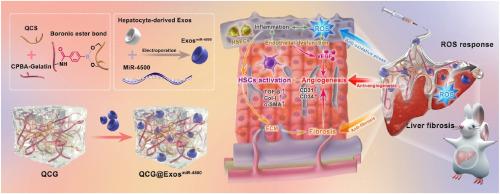ROS-responsive injectable hydrogels loaded with exosomes carrying miR-4500 reverse liver fibrosis
IF 12.8
1区 医学
Q1 ENGINEERING, BIOMEDICAL
引用次数: 0
Abstract
The reversal of liver fibrosis requires effective strategies to reduce oxidative stress and inhibition of hepatic stellate cell (HSC) activation. MiR-4500 regulates pathological angiogenesis and collagen mRNA stability, with the potential to inhibit fibrosis. Herein, we explored the inhibition of HSC activation in vitro by exosomes (Exos) carrying miR-4500 and encapsulated ExosmiR−4500 in an intelligent injectable hydrogel with biological activity and reactive oxygen species (ROS) responsiveness for application in oxidative stress environments. Briefly, reversible boronic ester bonds were integrated into gelatin-based hydrogels through dynamic crosslinking of quaternized chitosan (QCS) and 4-carboxyphenylboronic acid (CPBA)-modified gelatin. The QCS-CPBA-Gelatin (QCG) hydrogel scavenged excess ROS from the local microenvironment and released ExosmiR−4500 through the dissociation of boronic ester bonds, providing a favorable microenvironment and in situ sustained-release drug delivery system for ExosmiR−4500. The results showed that QCG@ExosmiR−4500 hydrogel has biocompatibility, biodegradability, and slow-release ability, which could effectively clear ROS and inhibit HSC activation and pathological angiogenesis in vitro and in vivo. Furthermore, transcriptome analysis suggests that the pharmacological mechanism of the QCG@ExosmiR−4500 hydrogel is mainly related to anti-oxidation, anti-angiogenesis, anti-fibrosis processes, and signaling pathways. Thus, our study demonstrates that an intelligently responsive ExosmiR−4500 delivery system based on injectable hydrogels is a promising strategy for the treatment of liver fibrosis.

负载有携带 miR-4500 的外泌体的 ROS 响应型可注射水凝胶可逆转肝纤维化
逆转肝纤维化需要有效的策略来减少氧化应激和抑制肝星状细胞(HSC)的活化。MiR-4500调控病理性血管生成和胶原蛋白mRNA稳定性,具有抑制肝纤维化的潜力。在此,我们探索了携带miR-4500的外泌体(Exos)在体外抑制造血干细胞活化的作用,并将ExosmiR-4500封装在具有生物活性和活性氧(ROS)响应性的智能注射水凝胶中,以应用于氧化应激环境。简而言之,通过动态交联季铵化壳聚糖(QCS)和 4-羧基苯硼酸(CPBA)改性明胶,将可逆硼酸酯键整合到明胶基水凝胶中。QCS-CPBA-明胶(QCG)水凝胶清除了局部微环境中过量的ROS,并通过硼酸酯键的解离释放ExosmiR-4500,为ExosmiR-4500提供了有利的微环境和原位缓释给药系统。结果表明,QCG@ExosmiR-4500水凝胶具有生物相容性、生物可降解性和缓释能力,能有效清除体内外ROS,抑制造血干细胞活化和病理性血管生成。此外,转录组分析表明,QCG@ExosmiR-4500水凝胶的药理机制主要与抗氧化、抗血管生成、抗纤维化过程和信号通路有关。因此,我们的研究表明,基于可注射水凝胶的智能响应ExosmiR-4500递送系统是一种治疗肝纤维化的前景广阔的策略。
本文章由计算机程序翻译,如有差异,请以英文原文为准。
求助全文
约1分钟内获得全文
求助全文
来源期刊

Biomaterials
工程技术-材料科学:生物材料
CiteScore
26.00
自引率
2.90%
发文量
565
审稿时长
46 days
期刊介绍:
Biomaterials is an international journal covering the science and clinical application of biomaterials. A biomaterial is now defined as a substance that has been engineered to take a form which, alone or as part of a complex system, is used to direct, by control of interactions with components of living systems, the course of any therapeutic or diagnostic procedure. It is the aim of the journal to provide a peer-reviewed forum for the publication of original papers and authoritative review and opinion papers dealing with the most important issues facing the use of biomaterials in clinical practice. The scope of the journal covers the wide range of physical, biological and chemical sciences that underpin the design of biomaterials and the clinical disciplines in which they are used. These sciences include polymer synthesis and characterization, drug and gene vector design, the biology of the host response, immunology and toxicology and self assembly at the nanoscale. Clinical applications include the therapies of medical technology and regenerative medicine in all clinical disciplines, and diagnostic systems that reply on innovative contrast and sensing agents. The journal is relevant to areas such as cancer diagnosis and therapy, implantable devices, drug delivery systems, gene vectors, bionanotechnology and tissue engineering.
 求助内容:
求助内容: 应助结果提醒方式:
应助结果提醒方式:


